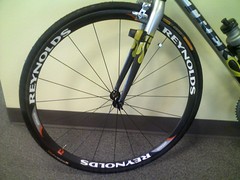The Attack wheels have been on my Trek for a week now and I’m reluctant to give them back.
First off they are Carbon Clinchers – “Everyday Carbon” they say. How cool is that? I prefer tubulars for race day, but I can guiltlessly ride these to work without fear of being stranded with a flat. I’ve been running them in place of my Bontrager Race-X-Lite Aeros and the difference is noticeable.
For race day, I have carbon race wheels – light, aero but super stiff they are not. When I get out of the saddle to sprint I feel like my front end is a little “whippy”. In the past I just assumed that was the fork, but after riding with the Attack wheel I know that’s not it. These wheels are SUPER stiff laterally. I’m not sure if it’s higher spoke count or the fact that as clinchers the rim is 5+mm wider, but they really hold up to the strain (more on the stiffness below).
One cool concept built into their rims that I’ve never seen before on carbon is that they put a “braid” on the braking surface. It’s some sort of fiber that wears better than traditional carbon and gives you better brake modulation. They suggest Baradine pads for best performance. I rode the rims wet to see how that that would be handled and rather than the typical “sliding” feeling of wet carbon braking, they were actually pretty similar in feel. Maybe everyday carbon is realistic after all.
Stiffer than #$%&
Trying to figure out what made the Attacks so stiff when he was riding them, Byron chatted with Reynolds product guy and learned that
“the 32MM Attack is the most compliant in what’s a stiffer rim overall because of the lay up. The lay up is intended to resist twisting and being vertically stiff, while also not harsh (not an easy task, I’m sure). He continued, “a wheel compresses into a oval shape with the rider’s weight and torque pushing and pulling the spokes. With the carbon clincher, the rim is rigid and stiff, no matter how high or low the spoke tension and that translates into better power transfer, which is what a rider feels as ‘stiffness.’”
What Byron described as a bit jarring on a commute is “stiff and on rails” in a race. He also noted that it’s very similar to when he switched to carbon bars and realized how much flex is in aluminum bars.
You don’t realize how much a wheel deflects or compresses until you ride one that doesn’t. The Attacks also climb exceptionally well, for not being very light, because of the power transfer.
Take the long way home
CyclingNews.com has also written the wheels and we saw a lot of consistencies to our experience, but we look at it as a way to cheat the commute. Solid, light wheels can buy me some time on the way home. That means a couple minutes quicker on the way home, or an excuse to squeeze a couple more miles in on a sunny day.
…We're riding townies, adventure, and mountain bikes. Find recommendations on our store page. As Amazon Associates we earn from qualifying purchases.
